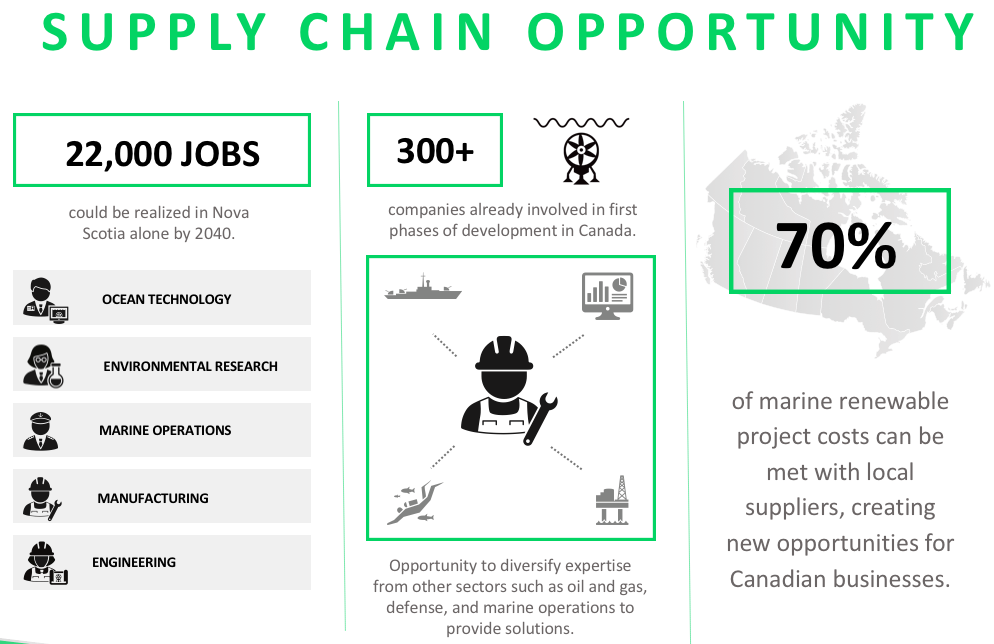Canadian Market

Canada has vast marine renewable energy resources, world-renowned test facilities, and existing human and capital assets in the energy and marine sectors. Together, they represent an opportunity not only for national activity but export.
Developing Canada’s marine renewable energy potential establishes a supply chain that can export innovation, technologies, and expertise to an estimated $900 billion global market. Capturing even 5% of global market share results in $45 billion by 2050.
Activity has already begun. The report Wave and Tidal Energy Market – Global Industry Analysis, Size, Share, Growth, Trends, and Forecast, 2016-2024 (Transparency Market Research) valued the global wave and tidal energy market at $497.7 million in 2014, and forecasts it may reach over $11 billion in 2024.
Canada
Canada’s Marine Renewable Energy Technology Roadmap (2011) forecasts that Canada could receive $2 billion revenue annually if 2,000 MW of generating capacity is installed by Canadian industry by 2030. Many of these projects will require design, engineering, project development, implementation and operation capabilities that already exist in many Canadian companies working with the marine fabrication, shipbuilding, shipping, offshore oil, and ocean technology sectors. Marine renewable energy presents a new market for these companies to tap into, as well as new jobs and careers.
The study Value Proposition for Tidal Energy Development in Nova Scotia, Atlantic Canada and Canada (Gardner Pinfold and Acadia Tidal Energy Institute) found that the marine renewable energy industry could contribute up to $1.7 billion to Nova Scotia’s gross domestic product (GDP), create up to 22,000 full time positions and generate as much as $815 million in labour income by 2040.
Marine renewable energy also offers an energy solution for rural and northern communities that currently rely on diesel generation. These projects can also allow for community participation and ownership, yielding significant local economic benefit.
Canada is well positioned to build a supply chain to develop a domestic sector and that can also be globally competitive. Canadian suppliers can meet 60-70% of the goods and services required for marine renewable energy development – most supplied at or near the tidal development site, bolstering rural economies.
This is already clear from early marine renewable energy activity in the Bay of Fundy. In the fabrication, assembly and installation of a 4-MW tidal project, Cape Sharp Tidal reports:
- More than 100 Canadian companies engaged
- 300 people contributing to the project
- $33 million in local contracts
World
The International Renewable Energy Agency’s Annual Review 2017 estimates a global total of 4,870 from ocean energy as of 2017.
The International Energy Agency’s Ocean Energy Systems (OES) estimates that there is the potential to develop 300GW of ocean energy by 2050, resulting in 680,000 direct jobs, and 500 million tonnes of CO2 savings. In light of this potential, countries such as UK, France, Ireland, the United States, and various countries in Asia and South America are establishing supportive policies and investing in the sector for both clean energy and economic reasons.
While previous forecasts have vastly overestimated global growth during the early stages of marine renewable energy development, the OES modeling indicates that marine renewable energy may experience similar rates of rapid growth between 2030 and 2050 as offshore wind experienced in the last 20 years.
The global marine renewable energy project supply chain continues to grow, including:
Quick Stats
- 300: Companies working in Nova Scotia MRE sector
- $500 million: Current world market
- $900 billion: Estimated world market potential, 2050
- 680,000: Estimated employment in MRE sector, 2050
- 22,000: Estimated employment in Nova Scotia MRE sector, 2040


